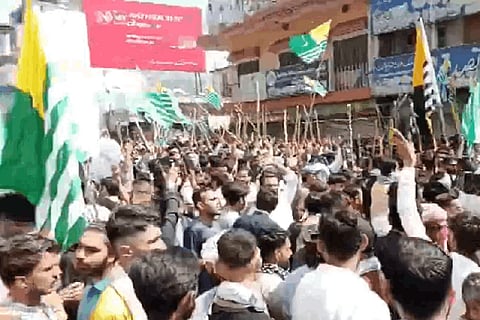

The intense protests in Pakistan-administered Jammu and Kashmir (PaJK) in 2022 and 2025 began as an organised, civilian movement led by traders, teachers, transporters and community groups under the banner of the Joint Awami Action Committee (JAAC).
Their grievances were tangible: high electricity tariffs, rising food prices, poor public services, and entrenched corruption.
Their 38-point charter of demands focused on subsidies, local management of hydropower revenues, open-merit educational admissions, and the abolition of special privileges for the political elite. It was a broad-based civic campaign for accountability, not an uprising against the constitutional order.
Initially, the government’s hesitant response allowed resentment to spread. By 2024, federal intervention became unavoidable. The process culminated in the October 4, 2025, agreement, a significant political document that committed billions in funds for electrification, new educational boards, healthcare improvements, infrastructure feasibility studies, and compensation for victims of past clashes.
The deal also promised to review police cases and alleged abuses through judicial oversight, while establishing a Monitoring and Implementation Committee to ensure compliance. On paper, it was a comprehensive step toward reform and reconciliation.
The test, however, lies in implementation. Delays in budget releases, bureaucratic inertia and political bargaining could still erode trust. If the monitoring committee lacks teeth or transparency, the pattern of protest followed by partial concessions could recur, deepening disillusionment.
Across the Line of Control, the picture is starkly different. In Jammu and Kashmir, the core issues are political and existential. Since August 5, 2019, when India revoked Jammu and Kashmir’s semi-autonomous constitutional status, residents have faced sweeping administrative, legal and demographic changes under an intense security clampdown.
Civil liberties have been sharply curtailed. Preventive detentions, media restrictions, and repeated communication blackouts have become tools of control. International human rights organisations and United Nations experts have documented serious allegations of abuse, arbitrary detention and collective punishment.
While some protests take civic or humanitarian forms, the central grievance is about political disenfranchisement, not so much about electricity bills or food subsidies. The instruments of redress here are political dialogue, constitutional guarantees, and human rights protections, not just local policy reform.
This difference in context and motivation means that responses must differ, too. Governance fixes can work in PaJK; they cannot substitute for political dialogue across the LoC.
Three practical reasons make it essential to separate the two narratives.
First, the solutions diverge.
PaJK’s challenges are administrative and distributive: ensuring services, transparency, and fair resource allocation. They can be addressed through sound policy, fiscal reforms, and participatory governance. In contrast, in J&K, grievances concern rights, representation, and the legitimacy of political authority. They require legal, constitutional and international engagement.
Second, messaging matters.
Equating PaJK’s reformist movement with anti-state militancy risks delegitimising genuine civic activism. Likewise, portraying struggle in Kashmir across the LoC as a demand for better services rather than for political rights misrepresents its core. Accurate framing helps policymakers and the media avoid deepening misunderstanding.
Third, credibility is at stake.
For Islamabad, addressing governance gaps in PaJK is both a moral and strategic imperative. A transparent, responsive administration strengthens its case when raising human rights concerns internationally. Conversely, failure to deliver on domestic promises undermines diplomatic standing and public faith alike.
What to watch in PaJK
The October 4 agreement offers a roadmap, but its success depends on follow-through. Three tests will determine whether it marks real progress:
· Transparency and timeliness: Public disclosure of budgets, project plans, and quarterly progress reports by the Monitoring Committee.
· Accountability: Independent judicial review of past violence, fair treatment of detainees, and impartial anti-corruption oversight.
· Civic inclusion: Involving JAAC and other community representatives in monitoring implementation and service delivery.
If these principles guide the next phase, PaJK could emerge as a model of responsive governance in a region where trust in authority is fragile.
On the other side in Jammu and Kashmir, the levers for change are fewer and the obstacles greater. The international community faces the limits of its influence, constrained by geopolitical interests and India’s firm rejection of external mediation.
Nevertheless, consistent, evidence-based human-rights monitoring, quiet diplomacy, and support for local civil society remain vital. Independent journalism, legal aid for detainees, and international advocacy through UN mechanisms can help protect the space for peaceful dissent.
Grand resolutions may be out of reach, but incremental progress — reducing arbitrary detentions, restoring communication freedoms, and enabling local governance — can still make a measurable difference.
The temptation to fold every Kashmiri protest into a single storyline is understandable but misleading. The crises of PAJK and J&K are connected by history and emotion, yet they are distinct in cause and remedy. One demands better governance and fair resource sharing; the other seeks dignity, rights, and political recognition.
Recognising that distinction is not an attempt to divide the Kashmiri, but to make it intelligible — and to respond to each part with the tools it requires.
For PaJK, that means accountable governance and the faithful execution of reform pledges. For J&K, it requires sustained, rights-based engagement by both regional and international actors.
Only when these approaches move in tandem — good governance where it is possible, justice where it is due — can stability, trust and peace begin to take root on both sides of the divided valley.
Have you liked the news article?